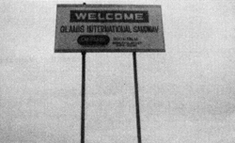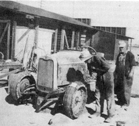History of Glamis
Schoolhouse to Dunebuggies
Written and composed by Carol Hales Allen and Mary Ben Kerckhoff. 1980
Neither entirely an autobiography nor a created story, it is the hope that this factual material provides informative and enjoyable reading. Much of the information you find here has been reduced into informative text, taken from the taped recordings, interviews, and letters compiled by Mary Ben Kerckhoff during an interview on April 29th, 1980 in the town of Glamis. The information was produced, creating the manuscript Schoolhouse to Dunebuggies. Most of this information will not be in its entirety. Most of the casual chit chat was left out, however, much of the information you see here was selected due to its informational or entertainment purposes pertaining to the Algodones Sand Dunes and surrounding deserts.
The original manuscripts and tapes can be located in the Yuma County Historical Society files.
Century House Museum
240 South Madison Avenue
Yuma, Arizona 85364
In 1979, a 100 yard sand drag strip called the
GLAMIS INTERNATIONAL SANDWAY was built
behind the Glamis Store. It was a very popular track,
and advertised for the March, 1982 WINTER SANDNATIONALS. The first night racing was scheduled
for Labor Day Weekend in 1982.
The track has since been closed.
_________________________________________________
Gold Diggers Club/ Imperial Gables.
In the early 30’s in the Chocolate Mtns. North east of the Glamis Beach Store was a ranch house that was used as a private club, the gold diggers club.
Here’s some information provided by Ike Harris:
“Paul Lowe wanted to promote this as a private club. He’d say to a prospective buyer, “OK, I’ll sell you that piece of land.” Maybe he owned it and maybe he didn’t, and he’d charge whatever the traffic would bear. If the customer had ahundred dollars, that was all right. If he had fifty, why that was all right. You could come out and dig for gold and then you got a share of the club, you could use the clubhouse. He had a few slot machines and he’d haul in some beer from Yuma and he created his private club. I understand it was quite popular. Then the war started and when the army was in this area they took over a lot of the area up there. Of course the officers used it, made an Officers Club out of it. So this was Paul Lowe’s method of operation and you’ll find a lot of old foundations, (pyramids of stone to mark claims)—Old timers who thought they’d bought property and staked a claim. They’d even build houses; you can find house foundations. Then during the Great Depression, men couldn’t find a job any place, so a lot of them could live around here without overhead expenses and mine enough gold for ‘bacon and beans.’ The weather was nice and all you had to worry about was groceries. This Paul Lowe though, he was really a character. He wouldn’t use a transit or anything. He’d just divide off a little piece of property and it was yours. In those days with gold going at thirty five dollars an ounce, if you got twenty five cents a day by dry washing, why gee whiz, you’d have enough to buy beans.”
The following information pertaining to the Gold Diggers Club was provided by Carol Hales Allen:
“The house itself was frame, with stucco and stones from the surrounding terrain and looked like a series of buildings joined together, as though it had been added onto when additional space was needed. Each section had a door which opened onto the veranda which extended across the front of the house.

Harold O. Weight, of the Desert Magazine, was in the Cargo Muchacho Mountains and invterviewed Al Allen in 1948. With the written permission of the current Publisher and Editor-in-Chief, Michael Vlasses, I quote:
“The Cargo Muchachos have more than rock, bug, and botany to offer. One day or one trip cannot possibly exhaust their attractions. A branch by the road by which I entered the mesa dividing the army camp site, goes northwest between the Ogilby hills and the main mass of the Cargos. In this pass, a well-traveled auto trail heads almost east into Jackson Gulch and to the Cargo Muchacho mine. The Gulch placers an oxidized surface ores of the Padre y Madre valley, still farther north, where first worked by Spaniards more than 150 years ago, according to publications of the California Division of Mines. The miners came from the settlement near the present site of Yuma which was destroyed by Chief Palma and his Yumans in 1781. M. L. Allen told me about the rediscovery of the Padre y Madre Vein. Allen lives in a cabin about half a mile below the Cargo Muchacho mine. He has a claim with paying ore there and plans erection of a 10-ton mil in the fall. He had just closed operations for the summer when I visited him. There have been years when he worked right through, but a severe attack of rheumatism made him feel his 68 years and he admitted that, at the moment, he couldn’t work quite as hard as he once did. He came to the Ogilby district 20 years ago for his health. Through personal investigation and contact with prospectors he has learned a great deal of its history.
 Allen said that the Mexicans and Indians worked the Padre y Madre long ago, carrying out the ore in cowskin bags. When they went away miners covered the rich vein. But the runoff waters finally uncovered the ledge. Allen, then working with Kenneth Holmes, visited the valley when a placer miner was making his final cleanup and bed rock. Allen thought the bedrock looked good and asked if he could take a sample. The placer miner told him he could take all he wanted. From that surface discovery came two tons of ore which reputedly paid $78,000 a ton. One piece, Allen says, was country rock that had been shattered and openings filled with seams of gold thicker than a knife blade.
Allen said that the Mexicans and Indians worked the Padre y Madre long ago, carrying out the ore in cowskin bags. When they went away miners covered the rich vein. But the runoff waters finally uncovered the ledge. Allen, then working with Kenneth Holmes, visited the valley when a placer miner was making his final cleanup and bed rock. Allen thought the bedrock looked good and asked if he could take a sample. The placer miner told him he could take all he wanted. From that surface discovery came two tons of ore which reputedly paid $78,000 a ton. One piece, Allen says, was country rock that had been shattered and openings filled with seams of gold thicker than a knife blade.
TheCargo Muchacho mine was apparently the first one in the district worked on a large scale. The name Cargo Muchacho, which can be translated ‘Loaded Boy’, reportedly was given to the area sometime after the Mexican Revolution when the children of Mexican miners placering* in the canyons played prospectors like their fathers and came home with shirts loaded with rich ore.
The mine is said to have been operated profitably for many years during the last century. But it was a ghost camp by 1905 and today and today big tailing piles are the only reminders of the early days.
Allen believes the Cargo Muchacho is going to a bigger mine than ever. The veins, he explained, are ‘stratisfied’. The developers of the mine thought they were going in on the bottom vein, but there were others which they had not found. Kenneth Holmes of Homes and Nicholson has been blocking out low grade ore in the mine. He cut through the footwall of the old ledge, Allen says, and hit two rich veins, one seven feet wide, one five. Assays have show up to a reported $97,000 a ton. There is talk of big milling operations this winter.
If the big strike materializes, it may mean another rush of prospectors. But whether or not gold brings new boom times to the Cargo Muchachos, the old mountains offer unquestioned attractions to those who like scenery, history and a few fine rocks to collect.”
END OF QUOTE
*Placermining is a style of mining where gold is found in the washes, having been washed down from the vein and deposited in the bed of the wash. This ore is dug out of the wash and put in a dry-washer, which shakes the rocks, leaving the gold back of the riffle on the canvas. Hard rock mining was a method of mining where a hole was put in the mine shaft where the possibility of reaching a paying vein. The hold was then filled with dynamite which exploded and broke up the rock. Then the rock is pulled out of the shaft in an ore bucket.












